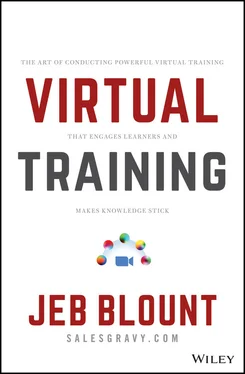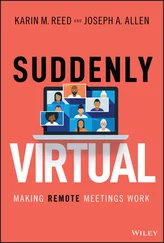Agility and flexibility. Virtual training may be delivered in almost any configuration over any duration.
Low risk and rapid iteration. It is easier to experiment and pilot virtual training initiatives because the risk and cost of failure is low. Likewise, virtual training may be deployed quickly and continuously improved with little risk to the organization or negative impact on the learners.
No walls and few limits. Learners may access virtual training sessions from almost anywhere. All they need is an internet connection and a connected device.
Session review. Virtual sessions may be recorded and made available for learners to review in the LMS. If a participant misses a session or needs a quick refresher, it is easy to catch up and stay on track.
Enhanced and extended communication. Interactive breakout groups and discussion boards make it easy for participants and instructors to collaborate, get feedback, and communicate both inside and outside of the classroom.
Structure and freedom. VILT provides both the structured, social learning environment that humans require for true behavioral change and freedom from the confines of the physical classroom.
The virtual training structure—a combination of scheduled live training sessions, in-classroom activities and breakout sessions, homework assignments, self-paced learning, and accountability—makes it far superior to e-learning and most classroom-based training.
One more fringe benefit of VILTs: they're green. Most modern organizations are focused on reducing their overall carbon footprint. Similarly, many employees are concerned about climate change and sustainability.
According to an Open University study, virtual training consumes about 87 percent less energy and produces 85 percent fewer CO 2emissions than classroom-based training. 5 One more reason to love virtual training.
1 1Christopher Pappas, “Top 20 eLearning Statistics for 2019 You Need to Know,” eLearning Industry.com, September 24, 2019, https://elearningindustry.com/top-elearning-statistics-2019.
2 2Justin Reich and José A. Ruipérez-Valiente, “The MOOC Pivot,” Science, January 11, 2019, https://science.sciencemag.org/content/363/6423/130.
3 3The Editors of Encyclopaedia Britannica, “Social Learning,” Encyclopaedia Britannica, September 13, 2019, https://www.britannica.com/science/social-learning.
4 4Richard E. Mayer, Multimedia Learning (Cambridge University Press, 2009), 175–188.
5 5Sally Caird and Robin Roy, “Sustainable Higher Education Systems,” in Encyclopaedia of Sustainability and Higher Education, ed. Walter Leal Filho (Springer Nature: 2019), https://doi.org/10.1007/978-3-319-63951-2_261-1.
4 Experience Is Everything
As our virtual training business exploded, many of my peers in our industry segment called to ask (and learn) about how we’d so quickly pivoted from in-classroom training to virtual. After I shared my story about building our virtual training studios, the responses that followed were typically along the lines of:
“Wow, you are way ahead of the curve.”
“Your timing was impeccable.”
“You are so far ahead of everyone else.”
“You really got lucky.”
I heard “You got lucky” a lot. Even from my own family. Trust me, in the moment, with so many other training companies taking it on the chin because they were not able to switch to virtual, I felt lucky.
But it wasn't luck. It was the cumulation of years of observation, experimentation, and hard work. A long time ago, we had recognized that virtual instructor-led training was important, and it was a methodology that we would need to master to be competitive in the future. We understood what didn't work, and why people have an aversion to virtual training. We also knew what we didn't like about delivering virtual training.
We were convinced that the biggest obstacle to gaining wider adoption of virtual training was the experience. Too often, VILT felt impersonal, low-energy, two-dimensional, and uncollaborative. For most learners it was about enduring a painfully boring and awful experience rather than engaging in actual learning.
The good news is that it's possible to control most of the things that make virtual training so bad:
Instructors who are unprepared or not trained to teach effectively in the virtual classroom
Poor training delivery methods and practices
Suboptimal virtual training production, including lackluster video, audio, backdrops, and framing
Media and graphics ill-suited for on-screen viewing
Failure to adopt and master the technology required to effectively manage a virtual classroom
Poor instructional design
Treating virtual training as an afterthought
All of these elements and more are easily resolved, if you have the will and desire to do so. This begins and ends with a focus on the mission.
Five Truths About Virtual Training Adoption
The most frequent concerns that learning and development professionals have about virtual is that clients, internal customers, and learners won't accept it. This was our biggest worry, too, but our experience has taught us five truths:
1 Most people prefer face-to-face training over virtual training—especially if they have had a bad experience with VILT in the past, which many have.
2 If the only option for training is virtual, most customers (the people paying for or ordering training) will begrudgingly accept that option.
3 If the cost (including travel, materials, and lost productivity) of virtual training compared to physical training is similar, most customers will choose classroom-based training.
4 If the cost gap (including travel, materials, and lost productivity) between virtual and physical training is large, most customers will strongly consider and often choose virtual training over classroom-based.
5 When the virtual training experience is outstanding, clients and learners are much more likely to choose VILT over classroom-based training for future deliveries, and they will book more future trainings than they would if they were only considering in-person sessions.
The brutal truth is that the experience matters more than anything. When you make VILT a great experience for your stakeholders (customers and learners), they'll begin to trust it and be open to more.
The one thing you can take to the bank, though, is that they won't accept virtual training if the experience is awful—no matter what the cost. If the choice is between affordable but bad VILT and unaffordable in-person training, customers will choose no training at all.
There are few people who haven't had the pleasure of sitting through agonizing virtual training sessions. Death by voice-over PowerPoint, delivered by a disengaged or clueless instructor, has an especially bitter flavor. I remember watching in dismay as my son endured one of his professors drone on for 20 minutes in a completely monotone voice-over while a single slide with 10 small bullet points filled the screen. The professor's audio was bad, and he never showed his face on video. Not once did he ask a question or engage his students. There wasn't even any movement on the slide. It was excruciating. My son drifted off into an app on his phone. I was livid that I was paying his private university $40,000 a year for this crap, and I fired off a scathing email to the president of his college.
This was exactly why so many of the executives we worked with were dead set against virtual training. It was why our clients' stakeholders believed that the cost for virtual training should be a fraction of what they paid for classroom training.
The reason there has been so much resistance from leaders, trainers, and participants to virtual training is because the experience has been awful. It's not because of the quality of the curriculum or content. It's not because of the talent of the trainer. It's the experience.
Читать дальше












